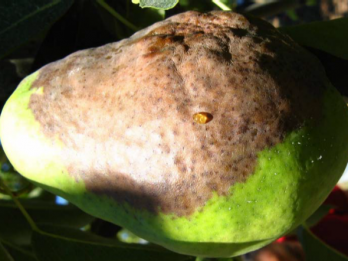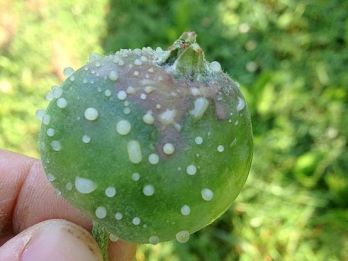Fire blight
Fire blight (Erwinia amylovora) is a devastating bacterial disease that infects a range of fruit trees.
Background
Fire blight was only found in North America until 1910 when it spread to apple and pear producing regions including New Zealand, Mexico, United Kingdom, Poland, Denmark, the Netherlands, Guatemala, the European Union, the Middle East, and parts of Asia.
The disease is not present in Australia. No treatments are available, only preventative measures. If fire blight becomes established, eradication will only be possible if it is detected quickly.
Impacts
Apple, pear and quince trees are vulnerable to fire blight, as are amenity plants such as cotoneaster, crab apple, flowering quince and hawthorn.
Young trees can be killed in one season, but it often takes several years of continuous dieback for death to occur.
Common entry points for the bacteria are through wounds, blossoms, and natural openings such as stomatas (tiny openings on leaves), or the nectar producing structures of flowers.
The disease is spread in orchards by heavy rain, birds, insects and pollinating bees, animals, and plants. Fire blight bacteria can spread further on clothing and equipment that has been in contact with infected plant material.
Management
Management
Growers can use on-farm biosecurity measures to reduce the chance of pests and disease getting onto their properties, including:
- using pest-free propagation material and seedlings, sourced from a reputable supplier
- putting up farm biosecurity signs on gates and fences to manage visitors coming onto your property
- avoiding sharing equipment
- keeping equipment and vehicles clean and free of plant matter
- wearing clean clothing before visiting other growers’ properties
- teaching farm workers on-farm hygiene practices, what to look for and how to report unusual pests and diseases
- report suspect symptoms to the Exotic Plant Pest Hotline.
Identification
Symptoms begin as dark green, water-soaked spots on the plant tissue. As the disease progresses, leaves rapidly wilt and die, taking on a black shrivelled appearance as if burnt. The twigs develop sunken cankers which can encircle the stem and cause dieback.
Fire blight looks similar to other bacterial or fungal diseases, or damage from insect attack or frosts. The key identifying features are:
- presence of bacterial ooze seeping out of cankers
- the unique shepherd’s crook shape of leaves.
Dead leaves can remain on trees and the branches may have a deep rust colour. Blossoms and fruitlets also develop a dark brown to black blight, or they die.



